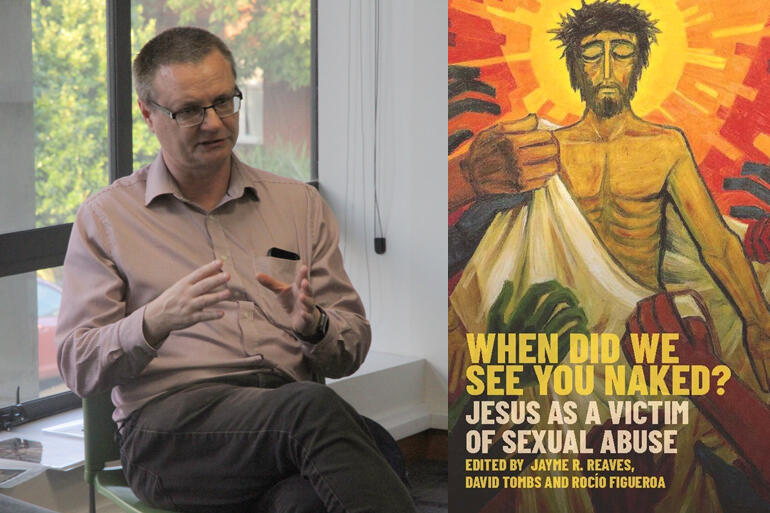
Warning: this story contains commentary related to sexual abuse
A new book by two Aotearoa-based public theologians and their UK colleague proposes that Christians should read the stripping and exposure of Jesus as a form of sexual abuse.
Anglican layman and Public Theology Professor Dr David Tombs (University of Otago), Catholic theologian Dr Rocio Figueroa (Catholic Institute of Aotearoa New Zealand, Auckland) and ecumenical theologian Dr Jayme R. Reaves (Sarum College, Salisbury) have written a new book entitled ‘When did we see you Naked? Jesus as a Victim of Sexual Abuse.
The new book is the result of many years’ work researching biblical narratives, state terror and sexualised violence in war and conflict, and survivors’ experience in order to challenge both church and society on cultures of silence, shame and blame.
“A strong pastoral and theological response is needed to sexual abuse and sexual violence in all its forms.” say the authors.
“If this [church] response is to be adequate it will need to be courageous and honest. It must be willing to confront difficult issues, stigmas and taboos, and not fall back on platitudes or abstractions.”
“The churches need a clear-sighted sense of the problem and an understanding of how its legacies continue to affect the lives of survivors long after the abuse itself.” (Figueroa & Tombs, Chapter 17)
Prof David Tombs first began work on the theological and pastoral implications of understanding Jesus as a victim of sexual abuse while researching the impact on victims of sexual violence in torture centres, where torturers used sexual violence to exert power and force degradation.
“I saw in those accounts how sexual violation was used as a profound way to attack a person not just physically, but to attack their entire psychological identity.” said David Tombs.
In addressing the question of Jesus as a victim of sexual abuse, the book sets out how sexual and gender-based violence was a common way that Roman power was enacted.
Within that context, the book shows how in Matthew 27: 26-31 Jesus was stripped naked three times on the way to the cross. While naked, he was flogged, humiliated, beaten about the head and dragged before a crowd of at least 400 heavily-armed soldiers who spat on him and jeered.
“In Christian art over the centuries these scenes have been tidied up to no longer represent the true nature of what we now know would have happened to Jesus.” said David Tombs.
The book also looks into other stories of sexual violence in the Bible as a way to understand some of the compound “secondary victimisation” that can happen to survivors.
“In the Bible we can read stories of abuse and see in them some of the same failures that society and churches around the world are still making in responding to abuse.”
For example, reading with today’s understanding of how abuse works reveals the reality of biblical women who were sexual abuse survivors. These are women we read about in the "texts of terror" in scripture, women who in a few biblical lines are quickly passed by as they experience kidnap and rape: such as the maidens of Shiloh in Judges 21: 16-25, Bathsheba in 2 Samuel 11, or Tamar in 2 Samuel 13.
David Tombs reports the research behind the book was informed in part by the very strong reactions earlier study had prompted from Christians who rejected any suggestion that Jesus could have been a victim of sexual violence.
Part of that is a misunderstanding of the context of imperial Rome, David says, but there is also a clue in that denial as to why sexual abuse survivors so often suffer secondary victimisation.
“People attach a purity stigma to sexual abuse, and that sense of stigma means they cannot accept that the Jesus they worship could have been abused. They cannot recognise Jesus as divine if he was sexually abused.”
One chapter of the book investigates the mixed responses of how five female survivors of sexual abuse in the church responded to the presentation of Jesus as a victim of sexual abuse.
Three survivors found understanding Jesus’ experience differently was helpful, one said the concept made no difference, and one said it would have been helpful to her at the time, but she no longer needed that perspective. The book reports how a previous study with male survivors also indicated a mixed response.
But the writers of the new book are clear their main audience is also the church itself. The questions they leave with Christian leaders and people are: ”What are the implications of the stigma that won’t allow people to see Jesus as a victim of sexual abuse?” "What does this say about how we view the humanity and innocence of survivors?"
“What effect could seeing Jesus as a victim of sexual abuse have on the church’s behaviour?
“How might the church behave differently as we choose to listen to, support and stand up for abuse survivors first?”
• An extract from chapter 17 - Seeing His Innocence, I See My Innocence
• Jayme Reaves and David Tombs explain why it matters that we acknowledge Jesus as a victim of sexual abuse.
Where to find help and support in Aotearoa New Zealand:
Shine (domestic violence) - 0508 744 633
Women's Refuge - 0800 733 843 (0800 REFUGE)
Need to Talk? - Call or text 1737
What's Up - 0800 WHATS UP (0800 942 8787)
Lifeline - 0800 543 354 or (09) 5222 999 within Auckland
Youthline - 0800 376 633, text 234, email talk@youthline.co.nz or online chat
Samaritans - 0800 726 666
Depression Helpline - 0800 111 757
Shakti Community Council - 0800 742 584
Where to find help and support in Fiji
Fiji Women’s Crisis Centre Domestic Violence Helpline Number: 1560
Phone: 3313300 (24 hour counselling)
Mobile: 9209470 (24 Hour counselling)

















Comments
Log in or create a user account to comment.